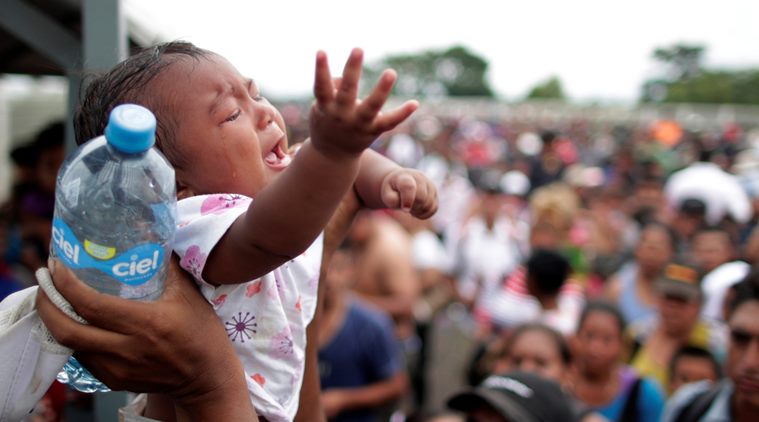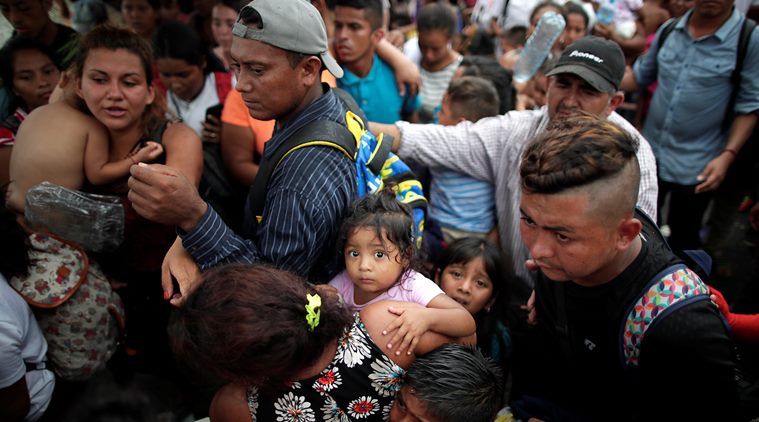Hundreds in migrant caravan turn back, some trickle into Mexico
After clashes with Mexican riot police on Friday, some 650 migrants from the caravan made it into Mexico on the far side of a bridge over the Suchiate River, according to Mexican officials who said they were being registered.

A baby cries as a caravan of migrants trying to reach the US, wait to apply for asylum in Mexico at a checkpoint in Ciudad Hidalgo, Mexico, October 20, 2018. (Source: REUTERS)
Hundreds of mostly Honduran migrants began the long trek home on Saturday, some using free bus tickets from Central American authorities, while many more members of a stalled caravan remained in Guatemala at a tense border crossing with Mexico.
After clashes with Mexican riot police on Friday, some 650 migrants from the caravan made it into Mexico on the far side of a bridge over the Suchiate River, according to Mexican officials who said they were being registered.
1m 34s

Migrant "caravan" in limbo at US border
About 150 Central Americans from a "caravan" of migrants in Mexico were camped out early on Monday at the U.S. border, some trapped inside a port of entry between the two countries, as officials barred them from stepping foot on U.S. soil.
Some 2,000 Honduran migrants were already back home after giving up on continuing to Mexico, Guatemala’s President Jimmy Morales said at a press conference in Guatemala City alongside his Honduran counterpart, President Juan Orlando Hernandez.
Hernandez said another 486 migrants were in transit back to Honduras, a roughly 12-hour trip by road.
“We are working to provide a peaceful and safe return trip and avoid that these movements keep happening in the future,” said Morales, who added that around 5,000 had amassed at the border seeking to enter Mexico.
The leaders of all three countries have come under intense pressure from US President Donald Trump, who for days has warned that the caravan must be stopped. Trump has made it a political issue in the November 6 midterm US congressional election, threatened to cut off regional aid, close the US-Mexico border and deploy troops there if Mexico failed to halt the migrants.
Hernandez noted that migrants from elsewhere in the region had joined the caravan, along with others from “outside the region,” though he did not cite specific nationalities. He added that planes would be used to fly children back home.
Some migrants at the Suchiate River border crossing, seized with uncertainty about their next moves, questioned whether so many had turned back. Others crossed into Mexico after swimming or using rafts to cross the river.
Amid confusion over the numbers following Friday’s chaotic scenes, a Mexican official said on Saturday that about 5,000 Hondurans were still waiting to enter Mexico from the Guatemalan side.
Many of the migrants, the overwhelming majority fleeing violence and poverty in Honduras, slept on the bridge through heavy rain overnight, dozens of them crammed against a metal border gate guarded by Mexican police.
At one point on Saturday, about 40 women or men with small children filed through the gate and past lines of officers to waiting buses as the crowd behind them watched.
“Are they being deported?” asked Duniel Hercoles, 26, from Chiloteca, Honduras, wondering where the buses were headed.
Mexico’s government has said it will process migrants’ claims for asylum individually.
SOME TURNING BACK
Most of the migrants spoken to by Reuters said their ultimate goal was to reach the United States. Some said they hoped to stay in Mexico, but that they had no idea how to get the documents needed to do so.
“For now we’ll wait,” said Honduran migrant Alexander Alvarado.
Most of the people now caught trying to enter the United States illegally hail from Honduras, El Salvador and Guatemala, among the poorest and most violent countries in the Americas.
The caravan members ranged from farmers and bakers to housewives and students, and included a whole block of friends and family from the Honduran city of El Progreso.
Jose Ramon Rodriguez, 45, a construction worker from El Progreso, sat on the Guatemalan end of the bridge late on Friday with his head hanging low, his 9-year-old son tucked against him.
“Tomorrow we go home,” he said. His companions nodded.
Among them was Osman Melgar, who nursed a bleeding gash on his shin, suffered when he fell as dozens of people packed on the bridge began fleeing when police, according to several eyewitnesses, used tear gas.
Some, including 40-year-old Adriana Consuelo, paid raftsmen 25 pesos ($1.30) to ferry them across the river on vessels constructed of giant rubber tires.
After making it to the muddy banks of Mexico, she said, “No one checked my documents,” as Consuelo headed to a taco restaurant.
But Mexico had stepped up its efforts to stop the flow of people, migration experts said.
“Every time there’s a (migrant) caravan there are police sent to the southern border … but we’ve never seen anything as dramatic as we’re seeing today,” said Eunice Rendon, coordinator of migrant advocacy group Agenda Migrante.
“This has everything to do with Trump,” she added.
 Children of Central American migrants, part of a caravan trying to reach the U.S., wait with their parents to apply for asylum in Mexico at a checkpoint in Ciudad Hidalgo, Mexico, October 20, 2018. (Source: REUTERS)
Children of Central American migrants, part of a caravan trying to reach the U.S., wait with their parents to apply for asylum in Mexico at a checkpoint in Ciudad Hidalgo, Mexico, October 20, 2018. (Source: REUTERS)









































No hay comentarios:
Publicar un comentario